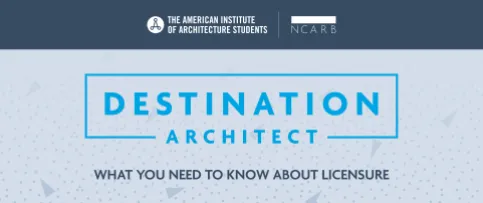With the 2014 IDP Coordinators Conference underway, we asked student coordinator Linaea Floden to share her tips for navigating the path to licensure—at any stage in your life.
Tell us about your role as a student coordinator.
At the University of South Florida (USF), the IDP student coordinator is an AIAS officer who also serves as chair of the IDP Advisor’s Committee. In this role, I provide education and training to the advisory team so students have easy access to information about our state’s education, experience, and examination requirements. As a team, we encourage our fellow students to tackle the licensure process, as well as help facilitate a culture of internship at the school.
The committee is currently developing two proposals to present to the USF faculty for their consideration and support. One includes adopting study group sessions for the Emerging Professional’s Companion, outside of the school’s curriculum and with some faculty oversight. These study sessions would be open to other emerging professionals in the community as well, like recent graduates, to extend the support the school offers to its students and alumni. We’re also working closely with AIAS to approach our local AIA chapter, AIA Tampa Bay, to take a pulse on firm interest in our area for adopting a type of coordinated internship that would include non-credit, paid hours in the studio and for-credit time in the classroom.
What’s the most common issue your interns face, and what advice to you give them?
The most common issue student interns face at USF is a lack of information. Many students aren’t aware that the activities they’re already doing count for IDP, or that the hours they’ve previously worked can be claimed for credit. NCARB does a great job, I think, of making that information available and accessible, but the students don’t know they should even be looking for it.
Often, we’re introducing them to NCARB for the first time. Beyond that, there’s also misinformation that hangs around the school—like that ancient, dust covered model still chilling in the corner of the professor’s office: a relic of another time and a different style. Most students still don’t realize that 1) It’s their decision when to start pursuing internship; 2) Waiting until after school to start thinking about internship is not the norm; and 3) It doesn’t have to take six years after graduation to earn licensure. The process can be much, much shorter if the student is proactive in managing and even budgeting their hours.
You’re juggling graduate school, an internship, and motherhood. How do you find the right balance between your work-home life?
I get asked this question a lot! Honestly, I put my family first. Any growth professionally or academically that would be gained by putting my family and faith second is unrealistic, unsustainable growth. But in this, I’m blessed to have children who understand and empathize with what their mom is trying to do. This phase in our lives certainly demands compromise and compassion from all of us, so it’s important that I demonstrate to my children how to cultivate that attitude, despite strenuous circumstances.
Logistically, I maintain a rigorous schedule for myself, and hold it just as sacred as any deadline at the office or in class. I get up early, often before 5 a.m., and get a jump-start on things so that any time after 7 p.m. can be spent devoted to cultivating the next generation of thinkers and makers. Admittedly, it is exceptionally difficult right now; I feel my passion being pulled in so many directions, and I have yet to see real evidence of progress or attainment of my goal. But there is hope! Architect Magazine recently interviewed Rosa Sheng of the Missing 32% Project, and I was absolutely inspired by what she shared about the complexities for women in architecture. My path to leadership in architecture may look different, but through all this life-balance stuff, I’m rigorously learning the critical skills of courage, collaboration, and mentorship. I trust that these skills will enable me to succeed and not become one of the missing 32 percent of licensed women architects.
How can high school students get a jump start on a career in architecture?
This is an exciting topic, now that NCARB has changed the eligibility requirements for the IDP to high school graduation. I think the biggest head-start high school students can get is by being exposed to the profession before they choose their educational path. The general public has limited understanding of what an architect actually does. When I share my major, I often hear people exclaim, “Oh you must be good at math!” No actually, I’m not. Architects are good at functional-problem solving, not necessarily math-problem solving. We are the ultimate problem-solving professionals. We could succeed in any multitude of career paths with the critical thinking skills we hone as part of our training, and yet, as architects we have the opportunity to mold and shape our world using pure innovation, creativity, and advanced technologies. I believe sharing this information with young students inspires them to look again at architecture.
To do this, we need our current professionals to reach out and bridge the gap. Getting involved with local students through volunteering, sharing how awesome architecture can be, and talking to them about what courses in their education can help guide them on this path, is a great way to start impressing and inspiring our youth about the profession.
What are you looking forward to at this year’s IDP Coordinators Conference?
Ah, the IDPCC is always so much fun. NCARB and AIA do such a great job to facilitate fellowship at the conference, and I always gain such valuable information to take back to my school. I look forward to hearing what other schools are doing to promote licensure upon graduation, what news is coming down the line for changes in the IDP, and catching up with the acquaintances I’ve made at the last conference.



